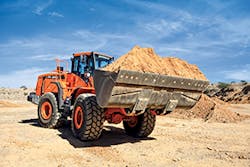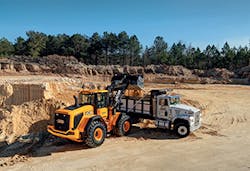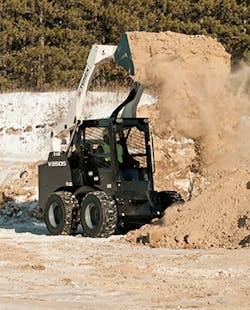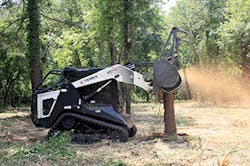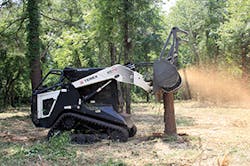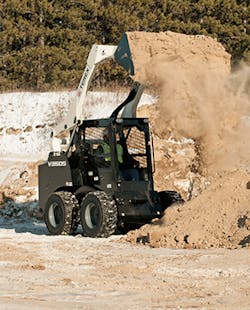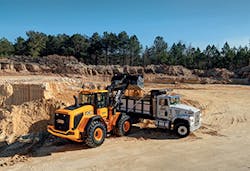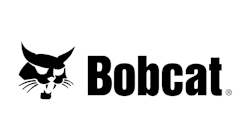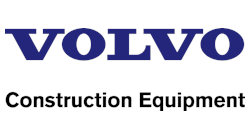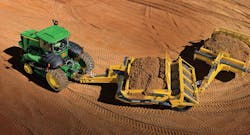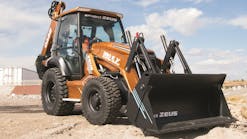In recent years, talk has shifted to the advantages of compact loaders, but whether or not compact equipment has become a trend in the construction industry, large loaders still fill a critical need. “People are not shying away from larger machines,” posits Nick Rogers, product specialist and inside sales coordinator for Liebherr Construction Equipment Co. “Some applications still require large loaders.”
Infrastructure is one such application, and Rogers says it’s growing. “Road construction requires aggregate; quarry work needs large high-production loaders.”
The Liebherr L586 is good for moving large aggregate at quarries. “It’s between a Cat 980 and 988,” he estimates.
But it’s the L586 that’s the star of excavating jobs. It’s a fully hydrostatically driven machine—the largest of its kind in the world, and comes standard with a 7.8-cubic-yard bucket, that has an operating weight of 69,000 pounds, and 335 horsepower.
The 586 features a Liebherr engine. “We make our own engines for the larger loaders,” explains Rogers. “It’s specific for the construction industry and serves as active ballast, or a counter-weight. Most machines require the addition of counter-weight for balance because their engine and drive components are mounted on the front side of the rear axle, but on the 586 the engine and hydraulic drive components are mounted on the rear side of the rear axle, which helps to stabilize the machine and creates a lighter, more efficient machine.”
It provides a competitive tipping load with a lighter machine, Rogers says, which contributes to better fuel economy and efficiency. “You can move more product with less fuel.”
Production is a big deal, he insists. “Producing more with less fuel is a benefit.”
Another one is efficiency, which is achieved through more torque and output to the driveline from the engine. The 586 supplies more power to the driveline with less waste: Specifically, 100% output from the engine to the driveline. That translates to no loss of torque or power. It also cuts down on fuel burn because it can run at lower RPM and stillprovide enough power to fill the bucket and run the machine. “More output, less fuel burn,” sums up Rogers.
He adds that while the 586 is in a class of its own, the 566 and 580 are in the same family; however, there’ a “big difference” between the 586 and the 580, which comes standard with 6.5-cubic-yard bucket, has an operating weight of 55,000 pounds, 288 horsepower, and an articulated tipping load of 40,785 pounds.
How to choose? “Look at the output needed to determine the size of the machine,” advises Rogers. “What’s the amount of product needed? What’s the discharge height? What are the road conditions? What are the carry cycles?”
If you can wait until September for Liebherr’s new model introduction, you can get a machine with even more power and efficiency. The upcoming Tier IV Final XPower line, with models L550-L586, will feature a new power-split drive line. “There will be two different drivelines: hydrostatic/hydraulic and mechanical,” explains Rogers. The output from the engine to the driveline system will depend on the load and the speed. For short cycles, the hydraulic driveline will supply power.
He says the power-split transmission provides the most efficient operation, with 30% fuel savings compared with competitors. It also allows the operator to maintain speed and power up-slope.
Placement of components due to the hydraulic driveline reduces cleaning and maintenance. “We moved the cooling package behind the operator cab, away from dust,” he says. “There’s no danger of debris causing damage.” Other features that make maintenance easier include a rear platform for engine access that eliminates the need for harnesses.
Production increases, along with the accompanying improvements in efficiency, capacity, tipping load, and bucket size, are important selling features of today’s big loaders. “We will definitely see larger loaders,” predicts Rogers.
Growing
Not only will we continue to see large loaders, but some manufacturers are also enhancing their line of big iron. Hyundai Construction Equipment Americas recently launched new versions of their HL900 series—the HL940TM and HL955TM—and added an XT version of each model through the largest 980, with extended reach, a longer boom, and higher dump height (an advantage in the ag industry).
Highway construction is up 20% and site development has seen 10% growth, according to Corey Rogers, marketing manager. That correlates to wheel loader growth. “We’re seeing the largest growth in the larger machines: 36%.”
Rogers credits some of the market increase to niche growth in the industry: small quarry and mining operations, infrastructure growth (moving materials), and stevedoring operations (loading barges).
Although equipment is trending larger now—tonnage, bucket, net horsepower—the trend depends on the work site. Don’t get larger equipment than the job constraints of the site to maximize productivity. “It’s the law of diminishing returns,” suggests Rogers. “Too big for the site constraints is slow.”
The biggest wheel loaders in Hyundai’s line are the HL970 and HL980, which replaced the 770. “It’s for mass production,” he explains. They feature bucket size of 5.5 yards and 7 yards, respectively. “We classify loaders by capacity.”
That bucket has been redesigned with a 5% increase for a larger fill factor. Other design changes include a Scania engine (versus Cummins) for productivity gains. The loaders are also reinforced with new steel and feature an enlarged spill guard, deeper throat, and curved side plates.
The redesign improved serviceability in the way of a tilt-back engine cowling for access at ground level and remotely located drains for coolant, engine, and transmission oil for easier access.
Ride control will reduce spillage and provide shock absorption to the boom.
A soft stop setting to slow cylinder stroke speed denotes less shock load on the boom cylinder. “It makes a good operator better,” says Rogers.
It also increases productivity and reduces fuel usage. In addition, reduced shock and bounce will improve durability, helping the machine last longer. It also provides a better ride for the operator.
Surgical land clearing with a Terex PT100
That’s where other improvements are focused. There’s a 10% volume increase inside the cab, making Hyundai’s one of the biggest in the market. Creature comforts include air ride seats, heated mirrors, and a 7-inch monitor with full-color touchscreen in a single cluster.
“We’re competitive on operating costs,” says Rogers. “The purchase cost is lower, our fuel efficiency is improved 10%, and our reliability means the contractor has more uptime.”
Operating cost is one factor in sizing a loader. Others include reach—the height of the hopper can rule out some smaller machines, terrain, material type, and the scale of the operation. “Calculation is a struggle. It’s hard to beat the agility of small loaders: speed versus size. Large loaders have more capacity—the fill factor—but aren’t always right for the job.”
A Good Match
Each job site and application has different needs, requiring the contractor to identify different factors in sizing equipment. For example, in loading applications, material density, production requirements, and truck bed height (to ensure the bucket can effectively dump the load) are the determining factors in calculating bucket size and loader, but for underground utility work, lifting capability will be more important. In addition, customers need to think about transportability if the loader is to be moved around job sites.
Whatever the application, in most cases, a loader is selected by the size of the bucket required for the job, says Lucas Sardenberg, a marketing consultant for Caterpillar. “However,” he adds, “in many cases, bucket size alone doesn’t tell the whole story.”
A Terex V350S moves dirt.
In underground utility work, productivity is based on the system of excavator and loader, so a good match is more important than bucket size. The same would apply for dirt moving or truck loading; it’s important to match the truck and the loader to ensure that the loader isn’t working too little or there is a constant long line of trucks waiting to beloaded.
When the match is right, the loader provides increased performance and capability while delivering “best-in-industry fuel consumption and maintaining the lowest owner and operating cost in the industry,” boasts Sardenberg.
Known for having some of the biggest, most efficient loaders in the business, Caterpillar offers similar technology across the various platforms: 950M, 962M, and 966M/966M XE. Caterpillar Production Measurement, or payload scales, is integrated into the machine with multi-color touchscreen display so operators can see what the payload is on the bucket and avoid over- or under-loading trucks.
Aggregate Autodig automates the digging cycle, which helps bring all operators to optimal performance while saving fuel. “We also offer object detection as an option, which integrates into the same display and provides operators awareness of obstacles or persons that are close to the back of the unit,” indicates Sardenberg. The system adjusts as the speed of the loader increases, relative to the object it detects.
Another safety feature is the optional LED lights, which are vibration resistant, last 40 times longer than halogen lights, and are much brighter. In addition, a light mounted on top of the cab indicates if the operator has the seat belt buckled.
Right-Sizing
CASE is one of the few manufacturers that does classify large wheel loaders by horsepower: under or over 240 hp. However, according to Andrew Dargatz, a brand marketing manager of wheel loaders for CASE Construction Equipment, there isn’t a specific cutoff point for performance and/or operating costs. It really comes down to right-sizing the machine to the application.
Loading up with a JCB 437
When right-sizing a wheel loader for a specific application, there are several things to consider. In addition to knowing the type and density of material to be moved or loaded, as well as the size of trucks or hoppers that will be loaded, it’s important to consider height clearance requirements.
Beyond material and volume, it’s important to gauge how much space the operator will need to safely maneuver the machine while loading, Dargatz says.
Visibility is important.
“Our customers’ primary concern is productivity—moving more material with the least amount of fuel and operator time,” he explains. “One way of looking at productivity is the most material moved with the least amount of operator time and fuel costs, but bigger isn’t always better. You want to load efficiently, but loading too quickly can result in the loader and operator sitting idle, waiting for more trucks to load. If a machine is loading too slowly, then the trucks end up waiting on the operator.”
To boost productivity, CASE wheel loaders are designed to focus on fuel economy, comfort, and productivity within current size classes.
“You’ll find that the performance specs on today’s larger wheel loaders have increased due to a variety of machine innovations,” points out Dargatz. “For long-haul applications, our loaders are equipped with five-speed transmissions and torque converters, which allow for improved operating speeds and fuel economy.”
F Series wheel loaders feature four power modes, which allow the operator to match the machine’s performance to the application. ECO mode optimizes fuel efficiency, Standard for quick loading, MAX for aggressive digging applications and an AUTO mode that matches engine response to an application on the fly.
They are also equipped with an Auto Idle feature, which reduces RPMs from 900 to 700 after the unit idles for one minute, as well as an automatic engine shutdown feature that shuts down or slows work/travel if key fluids are outside of normal range.
Additional technologies are incorporated to boost performance and overall productivity. Telematics provide machine output data that allows contractors to better understand a unit’s productivity: fuel consumption, idle time versus work time, and hour metering. It also provides an easy way to keep track of service and maintenance needs.
Trending Up
Horsepower and operating capacity of the loader are two important factors in loader selection, but spec’ing a loader for maximum productivity isn’t as simple as choosing the loader with the most horsepower, states Gregg Warfel, a district sales manager for Terex Construction Americas. Higher horsepower offers more dynamic force for pushing and production, but also translates to a heavier machine. If there are weight restrictions on the project site, he suggests a smaller horsepower unit.
“Horsepower is only one consideration,” says Warfel. He believes the decision depends on three factors: the type of work, ground conditions, and the time of year. “To get the quickest cycle times and the best productivity, you need to match the loader to the job site conditions.”
Additional factors include calculating the amount of material that needs to be moved per hour, the weight of the material, the type and density of the material, and the area that the loader will operate.
“It is important that you know how the loader will get the material, how quickly the material needs to be moved, and where the material needs to go,” he says. “The weight of the material and how quickly it needs to be moved will influence the size of the bucket you need; the bigger the bucket, the bigger the loader. You know it’s time to graduate up to a larger loader when you need the higher payload and larger bucket capacity.”
Know the loader’s operating capacity, including tipping load and lift capacities, when spec’ing the unit for a job. Terex loaders offer both radial lift-path and vertical lift-path configurations.
A radius lift-path skid steer loader has only one pivot point at the rear tower, allowing the loader to have a radius arch from ground level to full height when raising the boom. This configuration works better for ground engaging because of weight distribution between the wheels. Radius lift path units are more productive in grading and digging applications due to their balance of weight between the wheels. This even weight distribution between the wheels gives the units better cutting-edge pressure in those applications.
A vertical lift-path skid steer loader has more than one pivot point at the rear tower, which changes the geometry of the loader arm to lift higher, lift heavier, and reach farther when raising the boom to full height. This configuration is better suited for lift-and-carry applications, such as lifting heavy pallets and other material. A vertical path loader can carry larger buckets and reach further into the box of a dump truck, allowing the loader to center-load the truck better. They can also lift more weight as a result of the boom configuration, increasing its productivity.
Load-sensing hydraulics ensure that fuel and energy are not wasted on surplus hydraulic power, so operators can push material, dig, and grade the toughest job-site conditions, yet conserve power when requirements are less demanding. Thirty-gallon fuel tanks in the large-frame models enable longer operation between refueling.
Size does matter when choosing a loader, Warfel admits. The trend in the last decade even in skid steer loaders and compact track loaders has been larger units with more capacity, faster speeds, and longer, wider wheelbases for better stability in all ground conditions, as well as a smooth ride for the operator over rough terrain.
“Larger machines are most popular with owner/operators demanding more production, higher bucket capacities, and improved lifting capabilities because these capabilities are directly related to how much they can get done in a day,” says Warfel. General construction is the number one market for these types of machines.
He sees this trend for the larger frame units continuing to increase in popularity for several more years. “It’s time for contractors to graduate up to midi- or full-size wheel loaders or track loaders when they need the higher payload and larger bucket capacity.”
Sized to Fit
Contrary to that view, John Chesterman, the product marketing manager for production class four-wheel-drive loaders at John Deere, says that while all major manufacturers offer big machines, the customer is not going bigger in grading and excavation.
Bigger machines are more expensive. Operating costs are higher due to bigger fluid tanks, filters, and tires. Shipping is more expensive—and more complicated because bigger machines are also wider.
For example, John Deere just started selling the 944 it introduced more than a year ago. Weighing 120,000 pounds, the loader is designed for quarries. “It’s good for loading quarry haul trucks or feeding the crusher,” observes Chesterman.
Although the 944 is suitable for a wide variety of applications, he says it’s not typical for grading and excavating work. “The 944 is rare in grading and excavation. It leaves a big footprint because it’s so heavy. It needs firm footing: no mud or soft conditions. As machines get bigger, ground conditions become more important.” A better choice for grading and excavation jobs is the 744 with its five-yard bucket, or the slightly smaller 644.
The 944 features a hybrid electric drive system that Chesterman says no other manufacturer uses in this category. The benefits of this system are that one standard traction control prevents tire spin. “Tires costs $10,000 in a hard-digging environment where you could easily hit bedrock and lift the machine. Without traction aid, the tire spins out and the others don’t push, but with ours, the other tires still push. It cuts down on tire slicing.”
One benefit of the hybrid electric drive system is that when the momentum of the machine is driving, it recovers energy, taking load off the engine. Another is that electric motors put out max torque at near-zero speed for less loading on the engine. No torque converter is needed.
Sizing is done by bucket size, Chesterman says. Horsepower is just a productivity measure. “It’s driven by how much you need to lift. As loaders get bigger, buckets can carry more and lift higher.”
Sizing It Up
Clearly, it’s not as simple as choosing the biggest loader available. Many factors contribute to the calculation for determining the right size of loader for the job.
“There are a lot of categories,” says Mike Stark, with Doosan, “but bucket size is typically used.”
AEM data looks at horsepower, Stark continues, but horsepower is not the way you want to size a machine when you consider technology and hydraulics.
Instead, he advises, work backwards. “What’s your tip load? Figure out how much you can lift,” he says.
Bucket capacity is an important factor to consider. What do you need to lift? What do you need for the output per hour? Stark suggests observing job-site conditions such as turning radius, which will put constraints on the size of the machine, and cycle times. Look at the total picture: density, distance, what are you lifting, how much do you have to move.
Additional factors to calculate include the location of the material being hauled. If you oversize the bucket, the road surface is more critical. A bucket shouldn’t be wider than the wheels. If you size for capability, the machines can run at good speed.
“You can drive at 50% of the tip load,” notes Stark, adding that terrain and tires should be taken into consideration.
Cycle times are important because of the cost of employee labor. “You want to keep a steady pace—keep the trucks rolling,” says Stark. “You’re paying drivers to work, not to wait.”
Ideally, contractors want both productivity and fuel economy, which is why Stark thinks hydrostatic machines are a good choice. “They manage power better and save fuel because if you don’t need power, you can run in economy mode.”
Stark doesn’t see a lot of growth in the market for large loaders. He says the big machines in the “550 range” are more often found in quarries because they can haul a lot of material, but the business is not expanding, he insists.
Whether or not the market is growing, the machines are, at least for now. Ultimately, the upper limit in size for loaders will most likely be based on application, efficiency, and job site conditions rather than engineering.